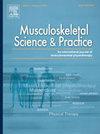Move to improve - Prescribing physical activity and deprescribing paracetamol for people with low back pain: Findings from a hybrid type III feasibility study
IF 2.2
3区 医学
Q1 REHABILITATION
引用次数: 0
Abstract
Objective
To evaluate the feasibility of implementing a culturally adapted multimedia intervention in the waiting room of a public hospital physiotherapy outpatient service to guide the implementation of a large multicentre trial investigating the effects of a multimedia intervention to promote physical activity and reduce paracetamol use in people reporting low back pain (LBP).
Methods
A six-month (March to September 2024) hybrid type III feasibility study was conducted in an outpatient physiotherapy department of a public hospital in Sydney, Australia. The intervention included a brief video and booklet designed to engage patients and encourage informed management of LBP. The RE-AIM (Reach, Effectiveness, Adoption, Implementation, and Maintenance) framework guided the evaluation. The educational materials were available in English, Arabic and Mandarin.
Results
The study revealed limited engagement, with only 11% of 688 potential people exposed to the intervention interacting with it. A total of 66 people completed the surveys (mostly English speakers), and six accepted to participate in a follow-up survey. Despite this low engagement, feedback from those who participated was positive. Satisfaction and usefulness ratings were high, with scores of 7.7–7.9 out of 10 for both video and booklet. Helpfulness was also rated positively, particularly for the video (8.6/10). Barriers to engagement included unfamiliarity with digital formats, video length, and the need for staff assistance in accessing the materials.
Conclusion
The findings suggest that the intervention, as currently designed, is not feasible for effective implementation in its present form. While engagement with the multimedia intervention was limited, findings allowed for a comprehensive understanding of the barriers and contextual factors impacting patient interaction. Notably, the majority of feedback was positive, with high satisfaction and usefulness ratings. The results underscore the need for alternative implementation strategies and further refinement of the approach to improve engagement with culturally diverse populations experiencing LBP and optimise outcomes in future implementations.
采取行动改善-对腰痛患者开具体育锻炼处方和解除扑热息痛处方:来自混合III型可行性研究的结果
目的评价在公立医院物理治疗门诊候诊室实施文化适应性多媒体干预的可行性,以指导开展一项大型多中心试验,研究多媒体干预对报告腰痛(LBP)患者促进身体活动和减少扑热息痛使用的效果。方法在澳大利亚悉尼某公立医院门诊理疗科进行为期6个月(2024年3月至9月)的混合型III可行性研究。干预措施包括一个简短的视频和小册子,旨在吸引患者并鼓励对LBP进行知情管理。RE-AIM(达到、有效性、采用、实现和维护)框架指导了评估。教材以英文、阿拉伯文和中文提供。研究结果显示,参与程度有限,688名潜在参与者中,只有11%的人参与了干预。共有66人完成了调查(主要是说英语的人),6人接受了后续调查。尽管参与度很低,但参与者的反馈是积极的。满意度和实用性评分很高,视频和小册子的得分都在7.7-7.9分(满分10分)。乐于助人也得到了积极的评价,尤其是视频(8.6/10)。参与的障碍包括不熟悉数字格式、视频长度以及需要工作人员协助获取材料。结论研究结果表明,目前设计的干预措施在目前的形式下是不可行的。虽然参与多媒体干预是有限的,但研究结果允许对影响患者互动的障碍和背景因素进行全面了解。值得注意的是,大多数反馈是积极的,具有很高的满意度和有用性评级。研究结果强调了制定替代实施策略和进一步完善方法的必要性,以改善与经历LBP的文化多样性人群的接触,并优化未来实施的结果。
本文章由计算机程序翻译,如有差异,请以英文原文为准。
求助全文
约1分钟内获得全文
求助全文
来源期刊

Musculoskeletal Science and Practice
Health Professions-Physical Therapy, Sports Therapy and Rehabilitation
CiteScore
4.10
自引率
8.70%
发文量
152
审稿时长
48 days
期刊介绍:
Musculoskeletal Science & Practice, international journal of musculoskeletal physiotherapy, is a peer-reviewed international journal (previously Manual Therapy), publishing high quality original research, review and Masterclass articles that contribute to improving the clinical understanding of appropriate care processes for musculoskeletal disorders. The journal publishes articles that influence or add to the body of evidence on diagnostic and therapeutic processes, patient centered care, guidelines for musculoskeletal therapeutics and theoretical models that support developments in assessment, diagnosis, clinical reasoning and interventions.
 求助内容:
求助内容: 应助结果提醒方式:
应助结果提醒方式:


